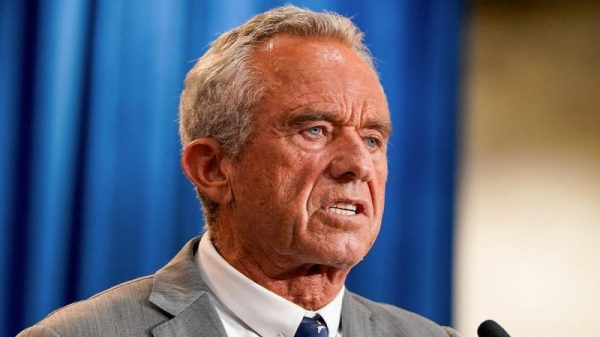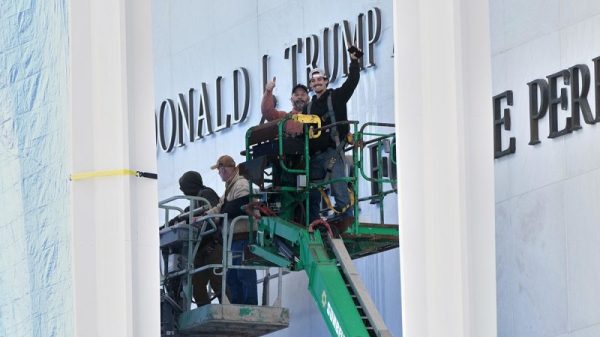A defense attorney for defendants charged in the 2021 attack on the U.S. Capitol posted a video on social media this week showing what appeared to be a sleeping guard at the D.C. jail complex, prompting an internal investigation at the long-troubled city detention facility.
The 80-second video was posted Tuesday on X by Joseph McBride, a New York-based criminal defense and civil rights attorney.
McBride said the recording was made more than a year ago and shows his client Ryan Nichols and a second Jan. 6 defendant, Jorden Mink — at the time pending trial on charges of assaulting police in the Capitol breach — “clowning” a D.C. jail guard leaning back in his chair and seemingly asleep at his desk.
“Every guard … they’re sleeping just like this man here,” Mink says in the video.
McBride said Nichols recorded the video after defendants realized that working cameras were included in jail-issued laptops provided to them to review the vast amount of electronic evidence in Capitol riot cases.
In a statement, a D.C. Department of Corrections spokeswoman said: “DOC has zero tolerance for staff sleeping while on duty. We are thoroughly investigating this incident.”
Asked about McBride’s account, corrections spokeswoman Setareh Yelle said, “Residents are required to receive additional legal resources, including a laptop, at the request of their defense attorneys, specifically for reviewing voluminous [evidence] or electronic discovery,” as in the Capitol riot cases. Any other use was a violation of the department’s policies, a spokesperson said.
The union for corrections officers could not immediately be reached Friday for comment.
In an interview, McBride said the video contradicts depictions of Capitol riot defendants as “a danger to society” — notwithstanding their convictions and court rulings upholding their pretrial detentions. In any event, the episode highlights how sleeping jail guards are a serious and recurring problem at the District jail and other American prisons.
Notoriously, two federal jail guards who were assigned to monitor Jeffrey Epstein on Aug. 10, 2019, the night he killed himself in his New York City cell, admitted to falsifying records to make it seem they were monitoring Epstein properly after they were accused of napping and browsing the internet. Charges against the men were dropped after they performed 100 hours of community service and cooperated with investigators.
Closer to Washington last October, Fairfax County Police and U.S. Marshals recaptured a prisoner who escaped custody while at a medical facility in the Richmond area while his guard slept. The prisoner was suspected of an armed carjacking in Montgomery County, Md., before he was apprehended.
Sleeping guards have been a concern for decades in the D.C. jail, a factor in attempted escapes or instances in which individual officers were left responsible for guarding more than 100 prisoners without backup, according to reports by The Post.
D.C. authorities have said it is a chronic challenge because jail officials can’t find enough officers who want the job to keep the staff at full strength, leading to a cycle of understaffing, exhaustion and absenteeism.
Staffing shortages were exacerbated during the pandemic. Near the height of the initial outbreak, the D.C. jail complex operated with one-third of its roughly 1,000 funded correctional positions unfilled or unavailable to work in April 2020, according to court records, fueling reliance on overtime and 12- and 16-hour shifts that were condemned by corrections worker union leaders and federal court investigators.
Those breakdowns and others culminated in a November 2021 announcement by the U.S. Marshals Service of plans to transfer hundreds of those incarcerated out of the 2,200-bed D.C. Central Detention Facility to a federal prison nearly 200 miles away after inspections prompted by a judge’s criticism found evidence of “systemic” mistreatment of detainees, including unsanitary living conditions and the punitive denial of food and water.
It wouldn’t be the first time that complaints shared on behalf of mostly White and conservative Jan. 6 defendants have drawn attention to problems long raised by poorer Black and Hispanic defendants who make up the bulk of the complex’s current, 1,900-inmate population and are mainly housed at a 48-year-old facility that has long been criticized by inmates, lawyers and judges. Replacing the complex has been a stated District goal since 2010, but is not expected to be done before at least 2034.
For example, a handful of Capitol breach defendants drew congressional attention to 23-hour-a-day coronavirus pandemic-era lockdowns at the jail, a problem faced by hundreds of D.C. jail inmates awaiting trial, most of them on local charges.
Similarly, the Marshals transfer came after a judge found jail officials failed to provide medical care to an accused member of the Proud Boys who was eventually convicted of four Jan. 6 felonies, including assaulting police.
While McBride has argued that riot defendants are being singled out as political prisoners, he said their experiences reveal problems behind bars faced by all inmates. McBride said that he and others began to stockpile videos that were transported out of the jail on zip drives or by inmates after they left the jail or were moved to other facilities.
In an interview, McBride said his point was simple: “If these guys are so … bad, why are the guards asleep in their pod” with radios and keys on their desk? McBride has also posted video from Nichols of bad jail food.
“It raises awareness of these guys’ plight, and it draws attention to Black and Latino men who suffer in places like Rikers Island and in D.C., people who are just locked up and dealing with the same stuff,” said McBride, whose other clients include Andrew Tate, the self-described misogynist influencer facing sex trafficking charges in Romania with his brother, Tristan Tate, and NXIVM sex “cult” leader Keith Raniere.
The relatively small number of Jan. 6 defendants subject to pretrial detention have benefited from being housed at the District’s smaller, newer Correctional Treatment Facility, which houses minimum- and medium-security-risk inmates including government cooperators and those requiring greater medical care. The jail said it moved riot defendants there for their safety and to prevent fights with the wider jail population. McBride said he believed the video was recorded during a one-hour break from pandemic-era lockdown, during which inmates in individual units or “pods” were allowed to socialize and access common areas.
Courts have upheld the pretrial detention of several dozen Capitol breach defendants — a small portion of the 1,400 charged, including 500 accused of assaulting or impeding police — finding that those accused of assaulting police, committing other violence or coordinating actions with others pose “a different category of dangerousness” to the public.
Nichols, a 33-year-old Texas man who brought two guns to a D.C.-area hotel and fought with police at the Capitol after declaring his intent to use force to stop Congress from certifying the 2020 election, was sentenced to 63 months in prison after prosecutors said he was in “a class of his own” among Capitol rioters. Mink, 30, of Pennsylvania, is serving a 51-month term after using a baseball bat to shatter two large Capitol windows, handing furniture to rioters outside, and then spitting and throwing several objects at police before striking at officers with a long pole.
A defense attorney for defendants charged in the 2021 attack on the U.S. Capitol posted a video on social media this week showing what appeared to be a sleeping guard at the D.C. jail complex, prompting an internal investigation at the long-troubled city detention facility.
The 80-second video was posted Tuesday on X by Joseph McBride, a New York-based criminal defense and civil rights attorney.
McBride said the recording was made more than a year ago and shows his client Ryan Nichols and a second Jan. 6 defendant, Jorden Mink — at the time pending trial on charges of assaulting police in the Capitol breach — “clowning” a D.C. jail guard leaning back in his chair and seemingly asleep at his desk.
“Every guard … they’re sleeping just like this man here,” Mink says in the video.
McBride said Nichols recorded the video after defendants realized that working cameras were included in jail-issued laptops provided to them to review the vast amount of electronic evidence in Capitol riot cases.
In a statement, a D.C. Department of Corrections spokeswoman said: “DOC has zero tolerance for staff sleeping while on duty. We are thoroughly investigating this incident.”
Asked about McBride’s account, corrections spokeswoman Setareh Yelle said, “Residents are required to receive additional legal resources, including a laptop, at the request of their defense attorneys, specifically for reviewing voluminous [evidence] or electronic discovery,” as in the Capitol riot cases. Any other use was a violation of the department’s policies, a spokesperson said.
The union for corrections officers could not immediately be reached Friday for comment.
In an interview, McBride said the video contradicts depictions of Capitol riot defendants as “a danger to society” — notwithstanding their convictions and court rulings upholding their pretrial detentions. In any event, the episode highlights how sleeping jail guards are a serious and recurring problem at the District jail and other American prisons.
Notoriously, two federal jail guards who were assigned to monitor Jeffrey Epstein on Aug. 10, 2019, the night he killed himself in his New York City cell, admitted to falsifying records to make it seem they were monitoring Epstein properly after they were accused of napping and browsing the internet. Charges against the men were dropped after they performed 100 hours of community service and cooperated with investigators.
Closer to Washington last October, Fairfax County Police and U.S. Marshals recaptured a prisoner who escaped custody while at a medical facility in the Richmond area while his guard slept. The prisoner was suspected of an armed carjacking in Montgomery County, Md., before he was apprehended.
Sleeping guards have been a concern for decades in the D.C. jail, a factor in attempted escapes or instances in which individual officers were left responsible for guarding more than 100 prisoners without backup, according to reports by The Post.
D.C. authorities have said it is a chronic challenge because jail officials can’t find enough officers who want the job to keep the staff at full strength, leading to a cycle of understaffing, exhaustion and absenteeism.
Staffing shortages were exacerbated during the pandemic. Near the height of the initial outbreak, the D.C. jail complex operated with one-third of its roughly 1,000 funded correctional positions unfilled or unavailable to work in April 2020, according to court records, fueling reliance on overtime and 12- and 16-hour shifts that were condemned by corrections worker union leaders and federal court investigators.
Those breakdowns and others culminated in a November 2021 announcement by the U.S. Marshals Service of plans to transfer hundreds of those incarcerated out of the 2,200-bed D.C. Central Detention Facility to a federal prison nearly 200 miles away after inspections prompted by a judge’s criticism found evidence of “systemic” mistreatment of detainees, including unsanitary living conditions and the punitive denial of food and water.
It wouldn’t be the first time that complaints shared on behalf of mostly White and conservative Jan. 6 defendants have drawn attention to problems long raised by poorer Black and Hispanic defendants who make up the bulk of the complex’s current, 1,900-inmate population and are mainly housed at a 48-year-old facility that has long been criticized by inmates, lawyers and judges. Replacing the complex has been a stated District goal since 2010, but is not expected to be done before at least 2034.
For example, a handful of Capitol breach defendants drew congressional attention to 23-hour-a-day coronavirus pandemic-era lockdowns at the jail, a problem faced by hundreds of D.C. jail inmates awaiting trial, most of them on local charges.
Similarly, the Marshals transfer came after a judge found jail officials failed to provide medical care to an accused member of the Proud Boys who was eventually convicted of four Jan. 6 felonies, including assaulting police.
While McBride has argued that riot defendants are being singled out as political prisoners, he said their experiences reveal problems behind bars faced by all inmates. McBride said that he and others began to stockpile videos that were transported out of the jail on zip drives or by inmates after they left the jail or were moved to other facilities.
In an interview, McBride said his point was simple: “If these guys are so … bad, why are the guards asleep in their pod” with radios and keys on their desk? McBride has also posted video from Nichols of bad jail food.
“It raises awareness of these guys’ plight, and it draws attention to Black and Latino men who suffer in places like Rikers Island and in D.C., people who are just locked up and dealing with the same stuff,” said McBride, whose other clients include Andrew Tate, the self-described misogynist influencer facing sex trafficking charges in Romania with his brother, Tristan Tate, and NXIVM sex “cult” leader Keith Raniere.
The relatively small number of Jan. 6 defendants subject to pretrial detention have benefited from being housed at the District’s smaller, newer Correctional Treatment Facility, which houses minimum- and medium-security-risk inmates including government cooperators and those requiring greater medical care. The jail said it moved riot defendants there for their safety and to prevent fights with the wider jail population. McBride said he believed the video was recorded during a one-hour break from pandemic-era lockdown, during which inmates in individual units or “pods” were allowed to socialize and access common areas.
Courts have upheld the pretrial detention of several dozen Capitol breach defendants — a small portion of the 1,400 charged, including 500 accused of assaulting or impeding police — finding that those accused of assaulting police, committing other violence or coordinating actions with others pose “a different category of dangerousness” to the public.
Nichols, a 33-year-old Texas man who brought two guns to a D.C.-area hotel and fought with police at the Capitol after declaring his intent to use force to stop Congress from certifying the 2020 election, was sentenced to 63 months in prison after prosecutors said he was in “a class of his own” among Capitol rioters. Mink, 30, of Pennsylvania, is serving a 51-month term after using a baseball bat to shatter two large Capitol windows, handing furniture to rioters outside, and then spitting and throwing several objects at police before striking at officers with a long pole.





















